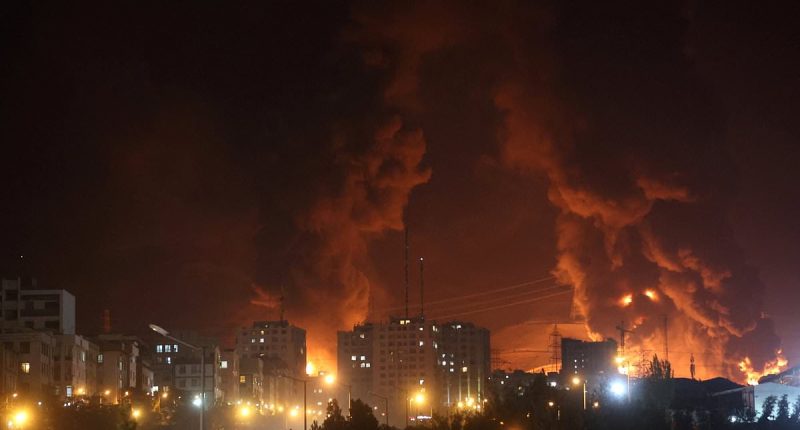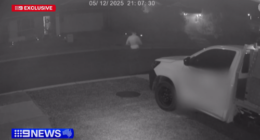Share this @internewscast.com
Mohsen Fakhrizadeh was driving to his holiday home in Absard, 50 miles east of Tehran, when Mossad caught up with him.
The father of Iran’s nuclear programme since the 1990s was driving his Nissan Teana luxury saloon with his wife in the passenger seat beside him and his bodyguards travelling in cars ahead and behind them.
As they passed a pickup truck on the Imam Khomeini Boulevard, a machine gun opened up – an M240C firing 7.62mm rounds, standard issue for the US army. But this was not an attack by American special forces. In fact, there was no one in the truck with the weapon at all.
Fakhrizadeh was hit by multiple bullets. After his car veered to a halt, he fell out of the door and collapsed, dying in a pool of his own blood.
At first the Iranian media had no idea how the assassination was carried out. Wild theories involving gunmen on motorcycles, a truck bomb and a platoon of special forces were aired. But the truth was more extraordinary than that.
Over a period of eight months, the machine gun was smuggled into Iran in pieces, along with explosives, and secretly assembled by a 20-man team, who also tracked Fakhrizadeh’s every move.
As one agent put it, Mossad ‘breathed with the guy, woke up with him, slept with him, travelled with him. They would have smelled his aftershave every morning if he had used aftershave.’

Prominent Iranian scientist Mohsen Fakhrizadeh

The attack that killed Mohsen Fakhrizadeh, pictured is his Nissan with the window shot at and his blood on the road
On the day of the assassination, a truck fitted with cameras was placed at the roadside, apparently ‘broken-down’, about three-quarters of a mile before the kill site – a position selected because it offered a good line of sight.
As Fakhrizadeh’s Nissan came into range, the machine gun’s telescopic sight used artificial intelligence to lock on to Fakhrizadeh’s face, fired 13 times and hit its target with such accuracy that his wife was not injured. It then self-destructed, blowing up the truck too.
Israeli sources later confirmed to me that this was not science fiction, a remote-controlled gun was indeed used – though they stopped short of taking credit for the kill.
This episode occurred in November 2020 but is typical of the fiendishly ingenious tactics employed by Israel’s intelligence agency, the most formidable service of its kind in the world.
Its extraordinary power was on display once again this month in Operation Rising Lion, the campaign of mass sabotage, destruction and assassination against Iran launched on June 13, in the most complex opening to any war fought in human history.
And it prepared the ground for an offensive that culminated in the surgical strike on Iran’s nuclear sites by B-2 bombers of the US Air Force equipped with bunker-busters.
The unofficial codename given to Israel’s long-term policy for crippling Iran’s military machine, wrecking its air defences and hampering its nuclear programme was ‘Death by a thousand cuts’.
The difference now is that all the cuts are coming at once. Apart from the 200 fighter-bomber jets flying sorties around the clock, hundreds of special forces soldiers have been operating secretly inside Iran, along with untold numbers of spies and double agents.
With weapons and munitions smuggled across the border, they have set off numerous car bombs and generally wreaked havoc.
Meanwhile, swarms of drones – operating from covert warehouses in Iran itself – have delivered their explosive payloads with pinpoint precision. Plus clusters of rockets, shells and ballistic missiles have hit targets the length and breadth of the country.
Even civilians have got involved. On Thursday, it emerged an Israeli telecoms executive working in Europe had been asked to help design a device that looked like a low-tech mobile phone but which could transmit encrypted data disguised as social media traffic.

Fire of Israeli attack on Sharan Oil depot on June 15, 2025
And a techie working at an Israeli health start-up was asked to tweak an algorithm he had worked on during his military service, to enable a dedicated server to sift through satellite images of fuel trucks and identify which ones were carrying missile propellant rather than petrol.
All this is ultimately the brainchild of one man – the head of Mossad since 2021, David Barnea. He’s the same top-level espionage chief who masterminded the exploding pager attacks that wiped out the high command and middle-ranking officers of Lebanon’s terrorist organisation Hezbollah last year.
Little wonder that within Mossad he is known as ‘a gadget-loving killing machine’. Indeed, the Iranians have become so paranoid that a hardline MP this week called for all ‘commanders, senior officials, nuclear scientists — and even their families’ to jettison their mobile phones.
Barnea almost never speaks to journalists but, in the course of co-writing my book Target Tehran – which attracted global attention last week after Israel’s prime minister Benjamin Netanyahu was pictured with a copy of it on his office desk – I found ways to build up a detailed portrait of him.
In the process I built up a detailed portrait of the man who is masterminding the war against Iran – laying plans and launching operations so ingenious that sheer panic is now spreading throughout the Islamic Republic.
The heads of Iran’s government, its army and its nuclear facilities literally don’t know what has hit them… nor what will hit them next.
By taking out the linchpin of Iran’s nuclear programme, Israel inflicted one of the deepest of its thousand cuts. Until then, perhaps the most damaging had been a heist executed by Mossad in southern Tehran, a blow as audacious as it was embarrassing to the Ayatollahs’ regime – the theft of all their nuclear secrets.
On January 31, 2018, two dozen Israeli spies and Iranian double agents broke into a drab warehouse with a corrugated iron roof in the industrial Shirobad district. They used blowtorches to break into a series of steel vaults before starting to remove files, both paper and electronic, that detailed every step of Iran’s nuclear research going back 30 years.
Over the next six-and-a-half hours, they loaded half a tonne of printouts and compact discs on to a truck before making their escape. By the time the Iranians discovered the break-in, multiple decoy vehicles were speeding in all directions to various borders.
The materials from this heist convinced America and Israel’s other allies, including the UK, that Iran truly was intent on building nuclear weapons. This was not a repeat of the Iraqi ‘super gun’ shambles, which involved a Canadian engineer trying to persuade Saddam Hussein that he could develop a huge artillery piece capable of firing missiles into orbit. Tehran was already very close to producing the enriched uranium it needed to make a bomb.
At the time, the head of Mossad was Yossi Cohen, a boisterous and charismatic man known for his dapper dress sense. Cohen is an alpha male, the kind of man who dominates the room.

Former head of Mossad, Yossi Cohen in his office in Jerusalem in 2016

Current Mossad director David Barnea at the Institute for Counter Terrorism summit in 2023
His protege and successor, Barnea, is quite different: calm, understated, quietly spoken, a man you might not notice – and perhaps wouldn’t remember if you did see him. Like Cohen, he began his career as a case officer, recruiting and handling agents in enemy territory, as well as a two-year spell as deputy head of Keshet, Mossad’s eavesdropping division.
But he also served in Sayeret Matkal, a key Israeli army Special Forces unit – as did Naftali Bennett, who had just become prime minister of the newly elected coalition government when Barnea took over Mossad.
Bennett, an expert on Iran, insisted on frequent intelligence briefings, and between them the two men agreed on the ‘death by a thousand cuts’ policy. They understood that the fundamentalist Islamic Republic was loathed by many ordinary Iranians, much as the Soviet Union was hated by millions of its citizens during the Cold War. And the Ayatollahs, like the Politburo, were bound to fall if enough pressure was applied.
‘The regime is profoundly incompetent and fairly corrupt,’ Bennett told me. ‘Large swathes of land don’t get water. You turn on the taps and you get mud. And people are very frustrated with the Islamic Revolutionary Guard Corps [IRGC], the Iranian armed forces.’
Three weeks after Barnea took charge of Mossad, the security services struck a direct blow against Iran’s nuclear facilities, in a meticulously planned assignment that now appears to have been a test run for Operation Rising Lion.
A plant near Karaj, about 25 miles west of Tehran, was attacked by a quadcopter drone which was able to drop a bomb on its roof – then returned to its launch location 10 miles away, ready to fly a future mission.
The factory, which manufactured parts for the centrifuges essential for uranium enrichment, was associated with the Atomic Energy Organisation of Iran [AEOI]. Tehran denied that the attack had caused significant damage but, for the next six months, international inspectors were denied permission to visit the plant.
This was a message to Ayatollah Khamenei and his ministers. Mossad now had free rein to be as aggressive as necessary.
‘We’ve been suckers,’ Bennett said. ‘Iran’s goal was to weigh us down fighting in Gaza and Lebanon, while they sit back happy in Tehran. They have to pay a direct price when they use proxies to hit us. Every time Hamas or Islamic Jihad shoots a rocket at an Israeli city, someone will pay a price in Iran.’

Video posted online last month appears to show Mossad agents operating inside Iran

The Mossad revealed footage showing its actions against Iranian air defences last month
One of those who received a bill from Mossad, according to my sources and foreign reports, was Colonel Hassan Sayyad Khodaei, the head of Unit 840, a secretive IRGC force operating outside Iran against Western targets and opponents of the regime.
Khodaei was gunned down by two assailants on a motorcycle as he sat in his car outside his home in downtown Tehran. Images on social media showed him slumped in the driver’s seat with the front passenger window shot out. The assassination was the first on Iranian soil of an official not connected to the nuclear programme.
This attack too can be seen as a dress rehearsal for Operation Rising Lion. Where targets were too well protected to be hit by drones, human assassins might be used. It’s impossible to know how many Israeli agents and commandos, both male and female, are inside Iran right now, but many will have been embedded for years.
Some might be disguised as loyal servants of the government, even trusted insiders such as bodyguards or nuclear workers. But others could be taking advantage of the deep divisions within Iranian society.
The Islamic regime is Shi’ite but in a country of 92million people, a sizeable percentage come from entirely different cultures: Sunnis, Kurds, Balochs and more. Some of them regard the Tehran government as occupiers in regions that should not even be part of Iran – and, on the basis that ‘my enemy’s enemy is my friend’, might be willing to lend support to Israeli special forces.
The successes of Operation Rising Lion have been astounding. They include the clinical removal of three very senior figures: the head of the Iranian armed forces, the commander of the IRGC and the commander of Iran’s Emergency Command.
‘These are three ruthless mass murderers with international blood on their hands,’ the Israeli Defence Force posted on social media. ‘The world is a better place without them.’ And then, to underline the message, Israel’s foreign minister Gideon Sa’ar announced that the replacement head of the armed forces, General Gholam Ali Rashid, had also been eliminated after just three days in his post, with a car bomb.
‘I would recommend that whoever takes on the post considers carefully,’ Saar said sarcastically, ‘and if they accept, they should exercise extra caution.’
Several top nuclear scientists have also been killed, including one who was in his apartment in a tower block. Photographs showed a drone-shaped hole in the side of the building and blast damage to a single room. Neighbouring flats on adjacent floors were apparently unscathed.
But another dimension to the strikes was perhaps even more important, even if it generated fewer headlines. Iran’s air defences have been effectively neutralised. And these were the first to go, because their removal was crucial if Israeli jets were to be able to attack the Natanz nuclear enrichment facility.
The regime was proud of its S-300 anti-aircraft missile systems, purchased at huge expense from Russia after 10 years of pleading. The S-300 is specifically designed to be deadly against F-15 and F-16 jets. These comprise a large part of Israel’s main strike force, ideal for dropping glide bombs on targets.
In October last year, Israel destroyed all the S-300s, ostensibly as revenge for a massive Iranian ballistic missile assault. We can now see this manoeuvre as one more far-sighted preparation for Operation Rising Lion.
My book, Target Tehran, predicted the war against Iran and, though no one could have foreseen all the ruses Mossad used, I envisaged in detail the waves of fighter-bombers after Iran’s air defences were obliterated.
Israel is fighting for its existence. And Mossad will be merciless.
- Target Tehran: How Mossad Is Using Sabotage, Cyberwarfare And Assassination To Stop A Nuclear Iran, by Yonah Jeremy Bob and Ilan Evyatar, is published by Simon and Schuster









